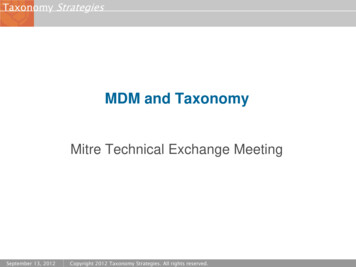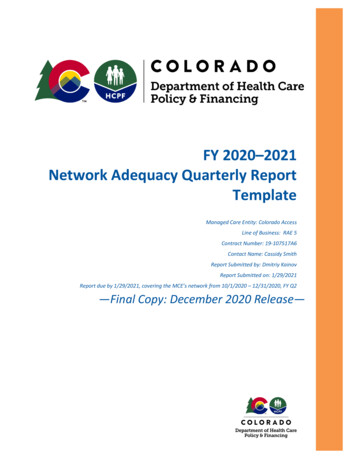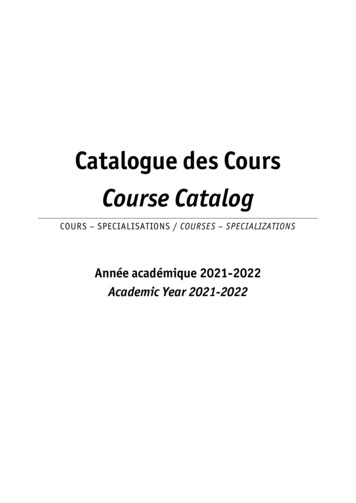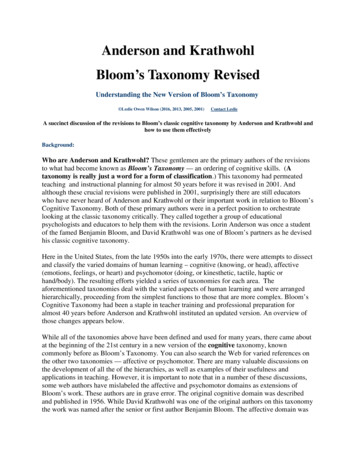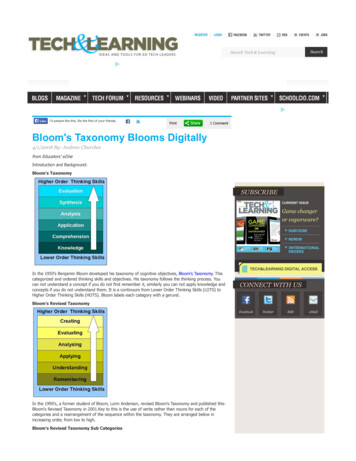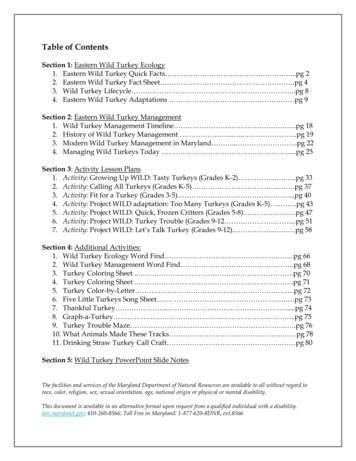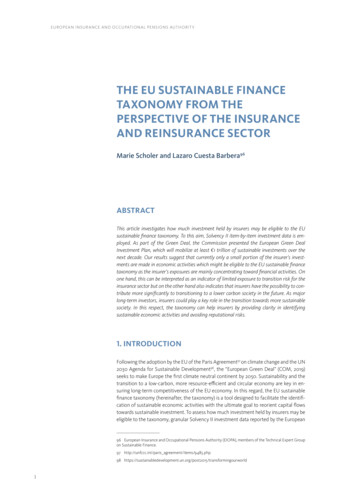
Transcription
EUROPE AN INSUR ANCE AND O CCUPATIONAL PENSIONS AUTHORIT YTHE EU SUSTAINABLE FINANCETAXONOMY FROM THEPERSPECTIVE OF THE INSURANCEAND REINSURANCE SECTORMarie Scholer and Lazaro Cuesta Barbera96ABSTRACTThis article investigates how much investment held by in surers may be eligible to the EUsustainable finance taxonomy. To this aim, Solvency II item-by-item investment data is employed. As part of the Green Deal, the Commission presented the European Green DealInvestment Plan, which will mobilize at least 1 trillion of sustainable investments over thenext decade. Our results suggest that currently only a small portion of the insurer’s investments are made in economic activities which might be eligible to the EU sustainable financetaxonomy as the insurer’s exposures are mainly concentrating toward financial activities. Onone hand, this can be interpreted as an indicator of limited exposure to transition risk for theinsurance sector but on the other hand also indicates that insurers have the possibility to contribute more significantly to transitioning to a lower carbon society in the future. As majorlong-term investors, insurers could play a key role in the transition towards more sustainablesociety. In this respect, the taxonomy can help insurers by providing clarity in identifyingsustainable economic activities and avoiding reputational risks.1. INTRODUCTIONFollowing the adoption by the EU of the Paris Agreement97 on climate change and the UN2030 Agenda for Sustainable Development98, the “European Green Deal” (COM, 2019)seeks to make Europe the first climate neutral continent by 2050. Sustainability and thetransition to a low-carbon, more resource-efficient and circular economy are key in ensuring long-term competitiveness of the EU economy. In this regard, the EU sustainablefinance taxonomy (hereinafter, the taxonomy) is a tool designed to facilitate the identification of sustainable economic activities with the ultimate goal to reorient capital flowstowards sustainable investment. To assess how much investment held by in surers may beeligible to the taxonomy, granular Solvency II investment data reported by the European96 European Insurance and Occupational Pensions Authority (EIOPA), members of the Technical Expert Groupon Sustainable Finance.97 http://unfccc.int/paris agreement/items/9485.php98 nsformingourworld1
FINANCIAL S TABILIT Y REPORTsolo insurers and reinsurers for Q3 2019 have been mapped against the economic activities covered the taxonomy through the relevant NACE99 codes. This overview will allowus to obtain a better idea to which extend insurers investments could contribute to thetransition towards a low carbon economy.2. THE EU SUSTAINABLE FINANCE TAXONOMYAND ITS USE BY INSURANCE AND REINSURANCEUNDERTAKINGSBACKGROUND AND OBJECTIVESIn 2016, the Commission appointed a High-Level Expert Group on sustainable financewith a mandate to recommend financial reforms on which to base the EU strategy onsustainable finance. Beginning of 2018, this expert group published a report (HLEG, 2018)advocating, among other recommendations, for the introduction of a unified EU classification system - or taxonomy – to provide clarity on which activities can be considered‘sustainable’.In order to gradually create such a unified classification system, the European Commission prepared a proposal for a regulation on the establishment of a framework to facilitate sustainable investment (Taxonomy Regulation) in May 2018100 and set up a Technical Expert Group (TEG) to develop recommendations on the technical criteria for theidentification of sustainable activities. In March 2020, the TEG published its final reporton taxonomy (TEG, 2020), which sets out the basis for a future taxonomy in legislation.The main goal of the taxonomy is to help investors and companies make informed investment decisions on environmentally friendly economic activities. The taxonomy isa classification tool with a list of economic activities with performance criteria for theircontribution to six environmental objectives: climate change mitigation; climate changeadaptation; sustainable use and protection of water and marine resources; transition toa circular economy, waste prevention and recycling; pollution prevention and control;and protection of healthy ecosystems.To be included in the proposed taxonomy, an economic activity must contribute substantially to at least one environmental objective and do no significant harm (DNSH)to the other five, as well as meet minimum social safeguards (e.g. OECD Guidelines onMultinational Enterprises and UN Guiding Principles on Business and Human Rights).METHODOLOGYIn practice, the taxonomy is a five steps process as shown in Figure 1. In order to usethe taxonomy, companies will first need to identify which economy activities could beeligible using the NACE industrial classification system of economic activities. Second,for each identified activity, they need to assess whether the activity meets the relevant99 NACE is the statistical classification of economic activities in the European Community and corresponds toa four-digit classification providing the framework for collecting and presenting a large range of statistical dataaccording to economic activity.100 osal-sustainable-finance en#risks2
EUROPE AN INSUR ANCE AND O CCUPATIONAL PENSIONS AUTHORIT Ycriteria for a substantial contribution. Third, they will also need to assess if the activity ismeeting the DNSH criteria. Fourth, it is also required to verify that the activity do not violate minimum safeguards. Finally, they will for example have to calculate the proportionof turnover aligned with the Taxonomy.Figure 1: Taxonomy - a 5 steps process.Identification ofeligibility byactivityThresholdcriteria forsubstantialcontribution?DNSH duedilligenceMinimumsocial safegueardsCalculationof percentage alignedSECTORS AND ACTIVITIESThe taxonomy will be developed gradually. The TEG report covers activities that makea substantial contribution to climate change mitigation and adaptation. More sectors andactivities will be added in the future, including activities that contribute significantly toother environmental objectives. The list of activities will also be reviewed on a continuous basis to cope with the technological developments.For climate change mitigation, the TEG identified six relevant macro-sectors based onGHG emissions (i.e. Agriculture, forestry and fishing; Manufacturing; Electricity, gas,steam and air conditioning supply; Water, sewerage, waste and remediation; Transportation and storage; Information and Communication Technologies). In addition, Buildings were identified as a critical cross-cutting issue, given their high contribution to CO2emissions in the EU; under the NACE-code classification Buildings would mainly correspond to two macro-sectors (Construction and Real estate activities, with applicationto other sectors where appropriate). For climate change adaptation, the TEG identifiedalso the provision of non-life insurance (corresponding to the macro-sector Financial andinsurance activities under the NACE classification) and Engineering activities and relatedtechnical consultancy (under NACE macro-sector Professional, scientific and technicalactivities) dedicated to adaptation to climate change.For economic activities within those sectors, technical screening criteria were developedin order to identify:››activities that are low carbon, already compatible with a net zero carbon economy;››activities that could contribute to a transition to a zero net emissions economy butare not currently operating at that level;››activities that enable low carbon performance or enable substantial emissions reductions;››activities that could contribute to build climate resilience substantially reducing thenegative effects of climate change.The TEG has identified priority activities within each sector (i.e. not all activities withina macro sector are eligible to the taxonomy). Table 1 provides the overview of all NACEmacro-sectors indicating whether they include economic activities currently covered bythe taxonomy, either contributing to climate change mitigation and/or climate changeadaptation.3
FINANCIAL S TABILIT Y REPORTTable 1: NACE macro-sectors codes covered by the taxonomy.NACE Macro-sectorsClimate changemitigationClimate changeadaptationüüC – ManufacturingüüD - Electricity, gas, steam and air conditioning supplyüüE - Water supply; sewerage; waste management and remediation activitiesüüF – ConstructionüüüüA - Agriculture, forestry and fishingB - Mining and quarryingG - Wholesale and retail trade; repair of motor vehicles and motorcyclesH - Transporting and storageI - Accommodation and food service activitiesJ - Information and communicationüK - Financial and insurance activitiesL - Real estate activitiesüüM - Professional, scientific and technical activitiesüN - Administrative and support service activitiesO - Public administration and defence; compulsory social securityP – EducationQ - Human health and social work activitiesR - Arts, entertainment and recreationS - Other services activitiesT - Activities of households as employers; undifferentiated goods - and services producing activities of households for own useU - Activities of extraterritorial organisations and bodiesREACTIONS TO THE TAXONOMYThe need of an EU taxonomy for the effective implementation of the entire EU reformson sustainable finance has been often highlighted (Siri & Zhu, 2019). However, the establishment of the taxonomy has encountered some critics related to the rigidity of administrative procedures to decide which activities are included in the official classificationas well as the lobbying and political pressure that could influence such decisions. Somepapers argue that a market-led approach could be more suitable in view of the dynamismin the field of sustainable finance, e.g. (Schoenmaker, 2018). Other critics highlight thatthe taxonomy follows a binary approach that neither takes into account the ‘shades ofgreen’ nor the context and consequently, it would not provide the necessary incentivesfor investors (Caldecott, 2019).The financial industry has overall welcomed the taxonomy but at the same time raisedthe practical challenges for its operationalisation, including availability of data and its4
EUROPE AN INSUR ANCE AND O CCUPATIONAL PENSIONS AUTHORIT Yquality and reliability, the need for additional expertise and increased costs due to thecomplexity of the framework. The insurance industry has also warned that a too narrowtaxonomy, covering a very small portion of the companies in the investors’ portfolio,would have a limited value (Insurance Europe, 2019a&b). It has also been highlighted thatthe taxonomy is a useful tool for the integration of environmental, social and governance(ESG) factors in investment decisions, however regulatory pressure should be avoidedto invest into assets just because they are in scope of the taxonomy (Pensions Europe,2018).USE OF THE TAXONOMY BY INSURANCE AND REINSURANCEUNDERTAKINGSAs risk managers, risk carriers and investors, the insurance industry has a vital interestand plays an important role in fostering sustainable economic and social development(UNEP, 2012). The insurance industry is increasingly integrating climate change considerations into their investment strategies and processes as part of the broader sustainabilitytopic (Geneva Association, 2018). The use of the taxonomy will be mandatory for financialmarket participants offering to the market “sustainable investments products”, includinginsurance undertakings that provide insurance-based investment products (IBIPs)101; butthe taxonomy can help the insurance sector more generally in the integration of sustainability considerations in their investments by providing common definitions and metrics.In 2019, European insurers had an estimated 11.4trn of assets under management. Considering that insurers are one of Europe’s largest institutional investor (in particular taking into account the role of life insurers as long-term investors), the success of the taxonomy in scaling up sustainable investments would necessarily rely on a significant levelof take up of sustainable investments by insurance and reinsurance undertakings. Table 2provides an overview of the main uses of the taxonomy by insurers and reinsurers.Table 2: Uses of the taxonomy by insurance and reinsurance undertakings.UseScopeProduct disclosureMandatory: Life insurance undertakings selling IBIPs marketed as“sustainable investment” or pursuing environmental objectives; forother IBIPs, comply or explain.Company disclosureMandatory:- Life insurance undertakings selling IBIPs marketed as “sustainableinvestment” or pursuing environmental objectives; for other lifeinsurers selling IBIPs comply or explain.- Insurance and reinsurance undertakings with more than 500employees.Voluntary: all other insurance and reinsurance undertakings.Investment strategy- Consideration of long-term impact of investments- Supporting stewardshipVoluntaryRisk management- Identification of sustainability risksVoluntary101 The Sustainability Disclosures Regulation (Regulation (EU) 2019/2088 of the European Parliament and ofthe Council of 27 November 2019 on sustainability-related disclosures in the financial services sector) providesspecific requirements of transparency regarding financial products that pursue the objective of sustainableinvestment or that have similar characteristics; these requirements will be supplemented by the TaxonomyRegulation. A compromised text was agreed in December 2019 on the text of the Regulation of the EuropeanParliament and of the Council on the establishment of a framework to facilitate sustainable investment, knownas “Taxonomy Regulation”.5
FINANCIAL S TABILIT Y REPORTIn case of IBIPs which are made available as “environmentally sustainable” or IBIPs thatpromote environmental characteristics, insurance undertakings will have to disclosewhich environmental objectives are pursued as well as a description of how and to whatextent the investments underlying the insurance product are invested in environmentally sustainable economic activities, as defined by the taxonomy. For other IBIPs, insuranceundertakings have the option to complete taxonomy disclosures or include a disclaimerthat the investments underlying the financial product “do not take into account the EUcriteria for environmentally sustainable investments”.In addition, insurance undertakings with more than 500 employees shall publish a non-financial statement which is expected to include information on how and to what extent the undertaking’s activities are associated with environmentally sustainable activities102; those undertakings should consider disclosing, among other indicators, the volume of financial assetsfunding sustainable economic activities contributing substantially to climate mitigation and/oradaptation (absolute figures and compared to total exposures) according to the taxonomy.103First mandatory disclosures against the taxonomy will be published in the course of2022. Beyond the mandatory and recommended disclosures foreseen in the EU legalframework, the taxonomy may also be used on a voluntary basis by (re)insurers in general (e.g. non-life insurers) in order to provide public information on their approach towardssustainable investment using a commonly accepted and scientific-based tool.Furthermore, insurers, irrespective of their size and whether they offer to the marketinvestment products as “environmentally sustainable” or not, are expected to considerthe sustainability of their assets (EIOPA, 2014) and to take into account the potentiallong-term impact of their investment decisions on ESG factors (EIOPA, 2019a)104. Insurers and reinsurers, based on the economic activities carried out by the companies theyare invested in, can use the taxonomy to better understand the potential impact of individual investments on climate change and other EU environmental objectives; they canalso use the taxonomy screening criteria to measure the (positive) environmental impactover time. This support can be very helpful since this area goes beyond the traditionalexpertise available in most of financial companies.The taxonomy can facilitate the engagement of insurers and reinsurers with investedcompanies on environmental topics, providing principles and metrics to consider asa reference in the dialogue and the exercise of voting rights to foster a move towardssustainability105 . It can also facilitate the dialogue with asset managers as regards theimplementation of the insurer or reinsurer investment strategy.Finally, the development of the taxonomy is expected to improve the industry’s effortsto consider transition as well as physical risks in setting their investment and risk management strategies (EIOPA, 2019b). When assessing the transition risk of their investments (and underwriting) portfolios, insurers and reinsurers could pay special attention102 See Non-financial Reporting Directive (Directive 2014/95/EU, amending Directive 2013/34/EU); the Commission committed to review the in 2020 as part of the strategy to strengthen the foundations for sustainable investment: adoption of a delegated act by the European Commission is expected by June 2021, in which this obligationshould be further specified, including the relevant differences for non-financial and financial companies.103 See Guidelines on reporting climate related information: /?uri CELEX:52019XC0620(01)&from 104 With respect to the relevance of sustainability and climate change for insurers’ investments, see Grund(2019) and Kaminker & Stewart (2012).105 With respect to the effective engagement with invested companies, including the consideration of socialand environmental factors, see De Jong, A. (2017)6
EUROPE AN INSUR ANCE AND O CCUPATIONAL PENSIONS AUTHORIT Yto their exposures in sectors covered by the taxonomy where the underlying companiesdo not comply with the relevant screening criteria or the DNSH criteria. Consequently,the taxonomy might also provide valuable information for the identification and assessment of sustainability risks, including reputational risk.3. REVIEW OF PREVIOUS WORKIn this section, we review three studies which have already considered the (re)insurer sinvestment portfolio in the context of climate relevant sectors and/or the taxonomy.In its Financial Stability Report in December 2018 (EIOPA, 2018), EIOPA analysed theclimate-related asset exposures of the European insurance sector106. Using Solvency IIasset-by-asset data, the insurer’s investment were mapped to the Climate Policy RelevantSectors (CPRS), developed in Battiston et al. (2017). The main CPRS macro-sectors arefossil fuels, utility, energy-intensive activities, buildings and transport. EIOPA estimatedthat between 10% and 13% of the assets held by insurers can be identified as climate-relevant. This amounts to more than 1 trillion euro in assets and corresponds to almosttwo-thirds of total own funds in the EEA; however a country-by-country comparison ofclimate-related exposures showed considerable heterogeneity across the EEA.The TEG report (TEG, 2019) also provides an overview of the exposures of institutional investors (including insurance corporations) in CPRS in 2018. The TEG report is focused on debtand equity securities issued by non-financial corporations resident in the EU; therefore, compared to the previous EIOPA study, the analysis in the TEG report covers a significant smallerportion of the EEA insurers’ portfolio (i.e. it does not cover either the securities issues byfinancial corporations nor the investments of European insurers outside the EU). The reportshows for insurance corporations an aggregate exposure in CPRS sectors through equityholdings of 176 bn., which is a moderate figure compared to other institutional investors,like investment funds or banks. The aggregate exposure in CPRS sectors through corporatebond holdings in 2018 amounted to 321 bn. for insurance corporations, being insurancecorporations the top holder of bonds in CPRS sectors. Exposures in CPRS sectors wouldrepresent 40.9% of the equities and 47,7% of the corporate bonds held by insurance corporations in the EU security market (excluding the securities issued by financial corporations).Finally, the Joint Research Center (JRC) of the European Commission published a technical report on the financial impact of the taxonomy (Alessi et al. 2019), providing anoverview of the equity and bond holdings of institutional sectors into holdings associated with taxonomy covered activities from 2013 to 2018. The JRC paper follows thesame approach of the TEG report but it develops the analysis with focus on the specificactivities covered by the taxonomy. It should be noted that the total number of activitiescovered by the taxonomy is much narrower than the list of activities covered by theCPRS classification. Although the CPRS classification is useful to assess the relevance ofeconomic activities with respect to climate change mitigation activities, the taxonomyincludes only those activities that can make a substantial contribution to climate changemitigation and adaptation (e.g. activities in CPRS sectors like mining and quarrying areexcluded from the taxonomy). Table 3 provides a mapping of the NACE macro-sectors inthe taxonomy and the CPRS, which gives an overview of the differences between them.106 The analysis considered equity, corporate bonds, property and mortgages and CIU. With respect to government bonds, see (Battiston et al. 2019).7
FINANCIAL S TABILIT Y REPORTTable 3: Mapping between the NACE macro-sectors in the taxonomy and the CPRS.NACE macro-sectors(in bold taxonomy covered)Climate Policy Relevant SectorsA - Agriculture, forestry and fishing6. AgricultureB- Mining and quarrying1. Fossil fuelC – Manufacturing3. Energy-intensive activities1. Fossil fuel5.Transportation9. OtherD - Electricity, gas, steam and air conditioning supply2. Utility1. Fossil fuelE - Water supply; sewerage; waste management andremediation activities2. UtilityF – Construction4. Buildings5. TransportationG- Wholesale and retail trade; repair of motor vehicles andmotorcycles9. OtherH - Transporting and storage5. Transportation1. Fossil fuelI - Accommodation and food service activities9. Other4. BuildingsJ - Information and communication9. OtherK - Financial and insurance activities7. FinanceL - Real estate activities4. BuildingsM - Professional, scientific and technical activities8. Scientific Research and Development9. OtherThe JRC analysis shows that for insurance corporations the share of holdings in taxonomyeligible activities related to activities in CPRS sectors in 2018 was around 15% for equitiesand around 20% for corporate bonds. Within institutional investors, the insurance sectorwould have the highest amount of bond holdings in taxonomy considered activities.4. E MPIRICAL ANALYSIS – MAPPING THE TAXONOMYTO (RE)INSURANCE INVESTMENT PORTFOLIOThe main goal of our study is to map current insurer’s investment to the taxonomy NACEcodes in order to assess how much investment held by in surers may be eligible to thetaxonomy. As described in section 2 of this paper (Figure 1), the identification of theactivities that could be eligible is the first step in the practical implementation of the8
EUROPE AN INSUR ANCE AND O CCUPATIONAL PENSIONS AUTHORIT Ytaxonomy. Measuring the level of sustainability would request the four additional stepsdescribed in Figure 1; that would require an individual detailed analysis asset-by-asset.Our analysis will give a first indication of the immediate relevance of the taxonomy forthe EU insurance sector as well as the potential challenges and limitation in the practicalimplementation of the taxonomy by (re)insurers.4.1DATAIn our analysis, similarly to what was done in the analysis conducted by EIOPA in the financial stability report (EIOPA, 2018) where the insurer’s investment were mapped to theCPRS, we will use the Solvency II asset-by-asset data reported by the European solo insurers for Q3 2019. This differs from the perspective used in the impact assessment (TEG,2019) and JRC (Alessi et al. 2019) analyses where the EU Security market was considered.The analysis is based on 213,495 individual assets reported, which have a total value of11,4 tn. The investments analysed are allocated as following: 32% Collective Investment Undertakings, 24% government bonds, 20% corporate bonds and 12% equity.The ISINs of the individual assets are linked to NACE codes using a proprietary data baseof the European Central Bank (the CSDB database). This ensures a uniform identificationof sectors per ISIN, including the full NACE code. In cases where ISIN is not reported ora match cannot be made, we rely on the NACE codes reported by the undertakings. Theanalysis will focus on the NACE codes (level 4) from the insurer’s investment as this is thelevel required to perform the mapping with the taxonomy. 71% of the ISIN CSDB NACEcodes were available at level 4. The ISIN NACE codes which were not available at level 4were therefore not considered in this study.The percentage of the asset value held by insurers per NACE macro sector for (a) all assets, (b) equities and (c) corporate bonds can be seen in Figure 2. Most of the (re)insurers’investments are made into the macro sector “K - Financial and insurance activities”107corresponding to 28% of all investments, 54% of equities and 67% of corporate bonds.107 Includes financials, covered bonds and holdings activities.9
FINANCIAL S TABILIT Y REPORTFigure 2: Percentage of the asset value held by insurers per NACE macro sector for(a) all assets, (b) equities and (c) corporate bonds (data source: Solvency II QRT data).(a) All assetsElectricity, [.], 1%Manufacturing, 3%Transporting [.] , 1%Information [.], 2%Other, 31%Financial [.], 28%CIU, 32%(b) EquitiesReal estate [.], 3%Real estate [.], 8%Manufacturing, 15%Electricity, [.], 2%Other, 16%Transporting [.], 1%Information [.], 5%Financial and holdings [.]* , 54%(c) Corporate BondsManufacturing, 7%Electricity, [.], 4%Real estate [.], 3%Other, 11%Transporting [.], 4%Information [.], 4%Financials, covered bonds and [.]**, 67%Note: Macro-sectors such as A - Agriculture, forestry and fishing, E - Water, sewerage, waste and remediation andF - Construction have been included in the category “Other” (i.e. category of non-relevant macro sectors for the taxonomy) as in comparison with the entire portfolio the investment values were minimal.*Financials, holding in “activities of holding companies K.64.2” and holding in related insurance undertaking (lifeK.65.1.1 and non-life K.65.1.2).**Financials, covered bonds and holdings in “activities of holding companies K.64.2”.10
EUROPE AN INSUR ANCE AND O CCUPATIONAL PENSIONS AUTHORIT YThe (re)insurers investment NACE codes were then mapped to the taxonomy NACEcodes. As described in Part 2, two (climate change mitigation and adaptation) out ofthe six environmental objectives have been addressed in the current taxonomy. It is important to note that despite a significant overlap, the NACE codes considered for theenvironmental objective “climate change mitigation” of the taxonomy are slightly different from the NACE codes considered for the environmental objective “climate changeadaptation” (see Table 1).4.2RESULTS(i) Overall, 5% of the total asset value (including Property assets) held by in surers maybe eligible to the taxonomy (see Figure 3). The largest majority of the assets eligible tothe taxonomy are invested within the EEA108 ( 4%). First, it is important to note thatthis number might understate the total assets held by in surers, which may be eligible tothe taxonomy, as further taxonomy-eligible assets could be held in funds in CollectiveInvestment Undertakings (about 32%) for which look-through was not possible. This isthe reason why in the following analysis we will focus on direct holdings on corporatebonds and equities as more information about the NACE codes are available for thesefinancial instruments. This relatively low amount of investment eligible to the taxonomycan also be explained by the fact that most of the (re)insurers investments are made intothe macro sector “K - Financial and insurance activities”109 (see Figure 2), which is noteligible for the taxonomy with the only exception of “non-life insurance” with respect toclimate change adaptation.(ii) For equities and corporate bonds, 13% and 6% respectively of the asset value heldby in surers for each financial instrument may be eligible to the taxonomy (see Figure 3).The higher share for equity investments is mainly explained by the equity holdings innon-life insurance companies (around 7% of total equity investments), which could beeligible with respect to climate change adaptation.110108 UK is included as Q3 2019 data are considered.109 Includes financials, covered bonds and holdings activities.110 Non-life insurance eligible for the Taxonomy includes selected LOBs and insurance products and servicesthat provide cover for climate-related hazards to activities and/or assets that are Taxonomy aligned. These criteria are conservative; however, the TEG has recommended a future review to increase coverage and enhanceusability.11
FINANCIAL S TABILIT Y REPORT(iii) Figure 3: Percentage of taxonomy eligible for all assets, equities and corporatebonds (Source: Solvency II QRT data).All assets1%1%95%5%3%Non eligible for taxonomyEligible - climate change adaptationEligible - climate change mitigationEligible – both(v)Equities7%87%13%2%4%Non eligible for taxonomyEligible - climate change adaptationEligible - climate change mitigationEligi
insurance activities under the NACE classification) and Engineering activities and related technical consultancy (under NACE macro-sector Professional, scientific and technical activities) dedicated to adaptation to climate change. For economic activities within those sectors, technical screening criteria were developed .


